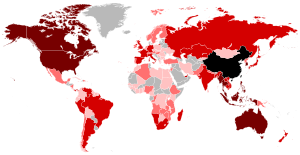
Back Seringas ANG صينيون Arabic صينيين ARZ Çinlilər Azerbaijani Ҡытайҙар Bashkir Kėnā BAT-SMG Dṳ̆ng-guók-nè̤ng CDO Intsik CEB Číňané Czech Kinesere Danish

The Chinese people, or simply Chinese, are people or ethnic groups identified with China, usually through ethnicity, nationality, citizenship, or other affiliation.[1]
Chinese people are known as Zhongguoren (traditional Chinese: 中國人; simplified Chinese: 中国人) or as Huaren (traditional Chinese: 華人; simplified Chinese: 华人) by speakers of standard Chinese, including those living in Greater China as well as overseas Chinese. Although both terms both refer to Chinese people, their usage depends on the person and context. The former term is commonly (but not exclusively) used to refer to the citizens of the People's Republic of China—especially mainland China.[2][3][4][5] The term Huaren is used to refer to ethnic Chinese, and is more often used for those who reside overseas or are non-citizens of China.
The Han Chinese are the largest ethnic group in China, comprising approximately 92% of its Mainland population.[6] They comprise approximately 95% of the population of Taiwan,[7][8] 92% in Hong Kong,[9] and 89% in Macau.[10][11][better source needed] They are also the world's largest ethnic group, comprising approximately 18% of the global human population.[12][13]
Outside China, the terms "Han Chinese" and "Chinese" are often wrongly conflated since those identifying or registered as Han Chinese are the dominant ethnic group in China.[14][15] However, there are also 55 officially-recognized ethnic minorities in China who are also Chinese by nationality.
People from Taiwan, officially the Republic of China (ROC), may also be referred to as "Chinese" in various contexts, though they are usually referred to as "Taiwanese". The territory of Taiwan is disputed and the ROC has limited recognition of its sovereignty.
The term "Overseas Chinese" is used to refer to people of Chinese origin living overseas as well as Chinese citizens residing outside China, but more commonly the former.
- ^ Harding, Harry (1993). "The Concept of "greater China": Themes, Variations and Reservations". The China Quarterly. 136 (136): 660–86. doi:10.1017/S030574100003229X. JSTOR 655587. S2CID 154522700.
- ^ https://www.zdic.net/hans/%E4%B8%AD%E5%9B%BD%E4%BA%BA Archived 27 March 2022 at the Wayback Machine 生息、繁衍,居住在中国的本地人或者海外有中国血统的侨胞 Local people who live, reproduce, reside in China, or Chinese nationals of Chinese descent living overseas.
- ^ https://cwn.ling.sinica.edu.tw/_process.asp?inputword=%A4%A4%B0%EA%A4H&radiobutton=1 Archived 1 October 2022 at the Wayback Machine 普通名詞。中華民族的族人或中國大陸的人民。 noun, ethnic groups of Zhonghua Minzu, or people of China
- ^ Pan, Lynn, ed. (April 1999). "Huaqiao". The Encyclopedia of the Chinese Overseas. Harvard University Press. ISBN 0674252101. LCCN 98035466. Archived from the original on 17 March 2009. Retrieved 17 March 2009.
- ^ Hui-Ching Chang; Richard Holt (20 November 2014). Language, Politics and Identity in Taiwan: Naming China. Routledge. pp. 162–64. ISBN 978-1-135-04635-4. Archived from the original on 30 September 2023. Retrieved 13 October 2018.
- ^ CIA Factbook Archived 13 February 2021 at the Wayback Machine: "Han Chinese 91.6%" out of a reported population of 1,379 billion (July 2017 est.)
- ^ 中華民國國情簡介 [ROC Vital Information]. Executive Yuan (in Chinese (Taiwan)). 2016. Archived from the original on 18 February 2017. Retrieved 23 August 2016.
臺灣住民以漢人為最大族群,約占總人口97%
- ^ Executive Yuan, R.O.C. (2014). The Republic of China Yearbook 2014 (PDF). Government Information Office. p. 36. ISBN 978-986-04-2302-0. Archived (PDF) from the original on 20 August 2017. Retrieved 11 June 2016.
- ^ 2016 Population By-census – Summary Results (Report). Census and Statistics Department. February 2016. p. 37. Archived from the original on 20 November 2017. Retrieved 14 March 2017.
- ^ 2016 Population By-Census Detailed Results (Report). Statistics and Census Service. May 2017. Archived from the original on 8 April 2020. Retrieved 25 July 2019.
- ^ Population By-Census 2016, p. 47.
- ^ Zhang, Feng; Su, Bing; Zhang, Ya-ping; Jin, Li (22 February 2007). "Genetic Studies of Human Diversity in East Asia". Philosophical Transactions of the Royal Society B: Biological Sciences. 362 (1482): 987–996. doi:10.1098/rstb.2007.2028. PMC 2435565. PMID 17317646.
- ^ Zhao, Yong-Bin; Zhang, Ye; Zhang, Quan-Chao; Li, Hong-Jie; Cui, Ying-Qiu; Xu, Zhi; Jin, Li; Zhou, Hui; Zhu, Hong (2015). "Ancient DNA Reveals That the Genetic Structure of the Northern Han Chinese Was Shaped Prior to three-thousand Years Ago". PLOS One. 10 (5): e0125676. Bibcode:2015PLoSO..1025676Z. doi:10.1371/journal.pone.0125676. PMC 4418768. PMID 25938511.
- ^ Cite error: The named reference
Chinese peoplewas invoked but never defined (see the help page). - ^ Cite error: The named reference
:0was invoked but never defined (see the help page).